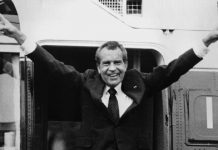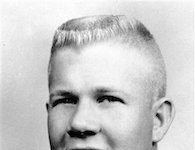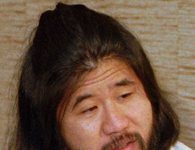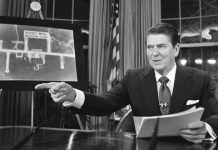On February 3, 1959, Buddy Holly, Ritchie Valens and the Big Bopper died in a plane crash. The day would be immortalized as “The Day the Music Died” in the Don McLean song “American Pie.”
The Day The Music Died
Buddy Holly was headlining the “Winter Dance Party,” a three-week tour through 24 midwestern cities featuring Ritchie Valens, the “Big Bopper” J.P. Richardson and Dion & The Belmonts. The grueling travel schedule and Midwest winter was hard for the musicians, especially after the heat in the tour bus stopped working.
On February 2, the tour stopped in Clear Lake, Iowa, to perform at the Surf Ballroom. Holly, frustrated by the bus rides, decided to charter a plane for after the show to take his band to the next tour stop in Moorhead, Minnesota.
Valens and Richardson, who were sick with a cold and flu, respectively, asked Holly’s bandmates to give up their seats for them. Holly guitarist Tommy Allsup gave Valens his seat after flipping a coin for it. Richardson got a seat from bassist Waylon Jennings, who later joked with Holly about losing his seat.
Holly said, “Well, I hope your bus freezes up,” to which Jennings replied, “Well, I hope your ol’ plane crashes.” Jennings would say later in his life that the exchange haunted him: “I was awful young, and it took me a long time to get over that.”
Holly, Richardson and Valens boarded the three-passenger plane, a Beechcraft Bonanza B3794N. It took off from Mason City, Iowa, around 1:00 a.m. on February 3, piloted by 21-year-old Roger Peterson, who had just worked a 17-hour day. Flying into a blizzard, the plane crashed into a cornfield shortly after take-off, killing all four men aboard.
The crash was blamed on pilot error; the low visibility due to the weather conditions would have forced Peterson to rely on instruments to determine where he was flying. An inexperienced pilot with limited knowledge of his instruments, Peterson likely flew the plane down instead of up.
The Civil Aeronautics Board’s official report on the accident states: “This accident, like so many before it, was caused by the pilot’s decision to undertake a flight in which the likelihood of encountering instrument conditions existed, in the mistaken belief that he could cope with en route instrument weather conditions, without having the necessary familiarization with the instruments in the aircraft and without having properly certificated to fly solely by instruments.”
Buddy Holly
Charles Hardin Holley was born in Lubbock, Texas, on September 7, 1936. He played guitar, banjo and mandolin by the age of 15, and by the mid-1950s was playing in a country duo with childhood friend Bob Montgomery. Holly turned to playing rock and roll in 1955, after seeing Elvis Presley perform in Lubbock.
“He loved Presley’s rhythm—it wasn’t country and it wasn’t blues—it was somewhere in the middle and it suited just fine,” recalls country singer Sonny Curtis, a childhood friend of Holly. “After seeing Elvis, Buddy had only one way to go.”
He was signed onto a record label in 1956. In 1957, Holly and his band, the Crickets, recorded “That’ll Be the Day,” which soon topped the pop charts. By 1958 the group had had seven Top 40 singles, including “Peggy Sue” and “Oh Boy!”
“Though Holly lacked the arresting sexuality of Elvis Presley, he nonetheless cut an engaging, charismatic figure with his trademark horn-rimmed glasses and vocal hiccup,” writes the Rock and Roll Hall of Fame.
YouTube has a video of Buddy Holly and the Crickets performing “Peggy Sue” on the show “Arthur Murray Dance Party” from December 29, 1957.
The Crickets split up in 1958, and Holly moved to Greenwich Village and married Maria Elena Santiago. Maria was pregnant with their first child when Holly was killed, but she had a miscarriage after the accident.
Though his career as a popular musician lasted only about a year and a half, Holly left an enduring legacy. He was innovative in his use of double-tracking and other studio techniques, and popularized the lineup of two guitars, a bass and drums that is used by many rock bands. He influenced 60s bands such as the Beatles, whose named is derived from the Crickets, and the Rolling Stones, whose first hit was a cover of Holly’s “Not Fade Away.”
Ritchie Valens
Richard Steven Valenzuela was born May 13, 1941, in the Los Angeles suburb of Pacoima, surrounded by Mexican music but also influenced by R&B vocal groups. He learned guitar and joined a local band when he was 16, and was eventually taken under the wing of Del-Fi label owner Bob Keane, with whom he produced his debut single, “Come On, Let’s Go.”
He would then release “Donna,” and “La Bamba.” “Donna” was later called “one of the classic teen love ballads” by rock critic Lester Bangs, and “La Bamba,” perhaps his most-remembered hit, “foreshadowed garage-rock, frat-rock and punk-rock,” according to the Rock and Roll Hall of Fame.
Sources in this Story
- Minneapolis Star Tribune: Buddy Holly: The tour from hell
- Time: The Day the Music Died
- NPR: What Went Wrong On The Day Music Died?
- The National Archives Catalog: Aircraft Accident Report
- City of Lubbock: Buddy Holly Center: Buddy Holly Biography
- Rock and Roll Hall of Fame: Buddy Holly
- YouTube: Buddy Holly on the Arthur Murray Dance Party 12/29/57
- Rock and Roll Hall of Fame: Ritchie Valens
- The Handbook of Texas: Richardson, Jiles Perry
- MSNBC: Big Bopper autopsy debunks foul-play rumors
The “Big Bopper”
Jiles Perry Richardson Jr. was born on October 24, 1930 in Sabine Pass, Texas. He earned the stage name of The Big Bopper in 1957 while working as a DJ at KTRM in Beaumont, Texas. He set a record in 1957 for continuous broadcasting for six days, spinning more than 1,800 records.
He would have his own chart-topping single in 1958 with “Chantilly Lace,” and other popular hits such as “Little Red Riding Hood” and “Big Bopper’s Wedding.”
Despite rampant rumors after his death that a gun of Buddy Holly’s found at the crash site was fired on the plane, an exhumation in 2007 found that there had been no “foul play” involved during the plane crash.
This article was originally written by findingDulcinea Staff; it was updated January 2, 2017.











